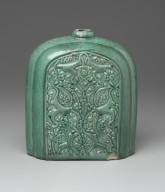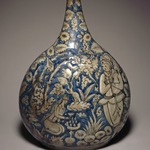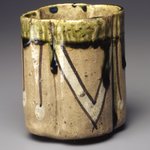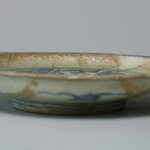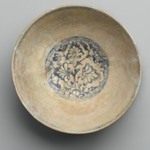

Pilgrim Flask, early 17th century. Ceramic; earthenware, molded and covered with a green glaze, 8 11/16 x 6 11/16 x 4 1/8 in. (22 x 17 x 10.5 cm). Brooklyn Museum, Gift of Mr. and Mrs. Frederic B. Pratt, 36.942. Creative Commons-BY (Photo: Brooklyn Museum, 36.942_front_PS2.jpg)
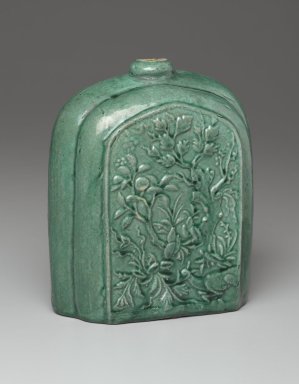
Pilgrim Flask, early 17th century. Ceramic; earthenware, molded and covered with a green glaze, 8 11/16 x 6 11/16 x 4 1/8 in. (22 x 17 x 10.5 cm). Brooklyn Museum, Gift of Mr. and Mrs. Frederic B. Pratt, 36.942. Creative Commons-BY (Photo: Brooklyn Museum, 36.942_threequarter_PS2.jpg)
Pilgrim Flask
Arts of the Islamic World
The pilgrim flask form was widespread in both time and place and was produced in a variety of media, including Venetian glass, Central Asian leather, and Chinese ceramics. Some have suggested that the round, moon-shaped form originated in the Near East, but no matter what the origin, the various examples bear witness to travel of both people and technologies throughout the diverse cultural landscape of the Silk Route.
This peacock-green pilgrim flask draws attention to the efforts of artists in seventeenth-century Safavid Iran to interpret the fine Chinese celadon wares widely exported under the Song (960–1279). Chinese products and designs were greatly admired and sought in Iran, where popular tradition and literature lauded the artistic talents of the Khitā’ī—natives of Cathay, a historical term referring to northern China. The lotus bud motif on this bottle may be inspired by Chinese images of the flower, but the molded composition of scrolling flowers and vines appears widely in Islamic vegetal decoration.
